САНИТАРНО-БАКТЕРИОЛОГИЧЕСКАЯ ОЦЕНКА ГОРОДСКИХ ПОЧВ
Аль-Раммахи Амир Абуд Карим1, Горовцов А.В.2
1Студент, 2научный руководитель к.б.н., Южный федеральный университет/Факультет биологических наук, Кафедра биохимии и микробиологии
САНИТАРНО-БАКТЕРИОЛОГИЧЕСКАЯ ОЦЕНКА ГОРОДСКИХ ПОЧВ
Аннотация
Объектом исследования были антропогенно-преобразованные почвы г. Ростова-на-Дону и их санитарное состояние.
Целью исследования было оценить санитарное состояние и потенциальный уровень опасности почв в г. Ростове-на-Дону.
Ключевые слова: урбаноземы, санитарное состояние, инфекции связанные с почвой, оценка качества почвы.
Al-Rammahi Ameer Abood Karim1, Gorovtsov A.V.2
1Master Student in Southern federal university/ Faculty of biological sciences/ Department of biochemistry and microbiology, Foundation of Technical Education-Iraq /Technical Institute – Kufa, 2Supervisor PhD in Biology, Southern federal university
SANITARY-BACTERIOLOGICAL ESTIMATION OF URBAN SOILS
Abstract
The object of research was the microbial community of soils in Rostov-on-Don and the sanitary conditions of these soils. The purpose of the research was the evaluation of sanitary conditions and potential threat level of urban soils in Rostov-on-Don city.
Keywords: urban soil, sanitary condition, soil-borne infections, soil quality evaluation.
Humans are in contact with soil permanently, either directly or indirectly via food, water and air; and thus soil may act as a vector and source of important human disease agents. Although many of the diseases associated with soil have been well characterized and studied, but many of the soil-borne diseases, especially bacterial diseases are still in unknown proportions of those pathogens on the ground (Scandura, Sobsey, 1997 ; Morris, Nguyen, 2004). Several soil borne pathogens have been implicated as causative agents of diarrhea (Leclerc et al., 2003). Soil has an important role in the transmission of many microorganisms that are responsible for many diseases like dysentery, typhoid, cholera, poliomyelitis, and others (United Kingdom Environmental Management: Water-Direct Report, 2010). Contaminants such as bacteria, viruses, heavy metals, and salt have polluted soil supplies because of inadequate treatment and disposal of waste products of human (Hamner et al.,2010).
In order to clarify this connection, diseases associated with soil have been classified depending on the origin (Scandura, Sobsey, 1997) of the etiological agent as follows:
(1) Soil-associated diseases, which are caused by opportunistic pathogens emerging bacteria that belong to the normal soil micro biota (such as Aspergillus fumigatus is a fungus common in soil and can infect the lungs by inhaling spores). (2) soil-related diseases, which result in intoxication from the ingestion of food contaminated with entero- or neurotoxins (Clostridium botulinum, C. perfringens and Bacillus cereus. (3) soil-based diseases Resulting from pathogens in the soil of origin (which include B. anthracis, C. tetani and Clostridium perfringens). (4) soil-borne diseases From enteric pathogens that occur in the soil by animal or human waste. Enteric pathogens transmitted by the fecal-oral route are bacteria, viruses, parasites and worms. Gastrointestinal infections are the most common diseases caused by intestinal bacteria (Rosen, 2000).
Object of study and materials:
The object of study was the microbial community of soils in Rostov-on-Don and the sanitary conditions of these soils. The soils of Rostov-on-Don can be classified as urbanozems or urbochernozems, and their upper layer is a mixed, contaminated layer of anthropogenic origin, known as “urbic”. Urbic horizon is contaminated with various organic and inorganic substances, including heavy metals, products of fuel combustion etc
Methods of study:
- Method of soil sampling
- Method of soil humidity determination
- Serial dilutions preparation method
- Method of plate- counting on solid media
- Method of deep inoculation
- Method of isolation to pure culture
- Method of most probable number (MPN) estimation) Coliform index estimation and Clostridium perfringens index estimation)
- 8.Method of concentrating of soil bacteria from suspension
- Methods of identification of isolated bacteria( qualitative analysis)
Results and discussion:
During the period from June, 2013 to January, 2014 6 soil samples have been taken from several areas of the Rostov on Don city. A number of groups of bacteria have been evaluated in soil samples, some of them isolated to pure culture for further identification. The estimation included: total number of bacteria, Enterococcus index, total coliform index, Clostridium perfringens index, thermophilic bacteria index. The results are presented in table 1.
Table 1 - The results of quantitative analysis of soil samples, taken in different areas of Rostov-on-Don
All the numbers have shown large difference between different areas of the city, as well as they shown clear seasonal dynamics. For the total count of bacteria, the difference between areas reached as high as 80 times between different areas and exceeded 10 times between the seasons. For the other microbiological indices the difference was even higher. This corresponds to rapid reaction of soil bacteria to the changes in soil ecological conditions and shows that the sources of contamination in different parts of the city strongly vary. According to Table ( 1), we have constructed graphs in (Figure 1,2,3,4,5) :
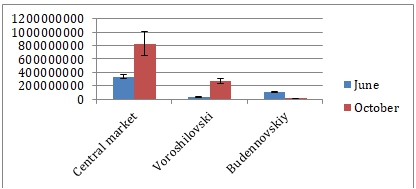
Fig. 1 - The total number of bacteria in soil samples, collected in Rostov-on-Don
In this examination we have observed an increase of the total bacterial count in the central market in both June and October. The total number of bacteria in this soil sample was significantly higher, than in both Budennovsky and Voroshilovsky streets (3-80 times and 3-10 times respectively). This increase is probably due to the fact that this zone of the city is crowded with people and contains the meat market and fish market nearby. This can lead to addition of organic waste to the soil surface and rapid growth of total bacterial numbers.
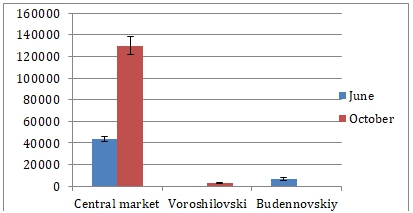
Fig. 2 - The index of Enterococcus in soil samples, collected in Rostov-on-Don
The index of Enterococcus in soil closely resembled the data on total bacterial count with a statistically significant level of correlation (r=0,96), which can lead to assumption, that at least some part of bacterial, enumerated via total count originate from fecal contamination. Enterococcus is an important fecal indicator microorganism, and under some conditions it can accumulate, and even multiply in soil, becoming a major environmental threat (Fujioka et al, 1998).
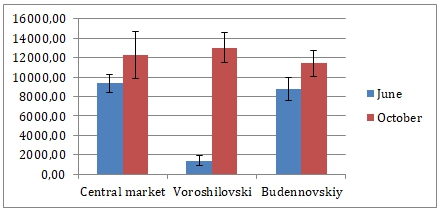
Fig. 3 - The index of thermophilic bacteria in soil samples, collected in Rostov-on-Don
The number of thermophilic bacteria was least linked to other microbiological estimations of soil quality. The correlation between the number of thermophilic bacteria and other groups in this research varied from 0,35 to 0,47 and it never reached the level of statistical significance. This means, that this is a completely separate estimation of soil quality. Opposite to other groups of bacteria, the number of thermophilic microorganisms was not so much different in the central market soil, compared to the two other sampling spots.
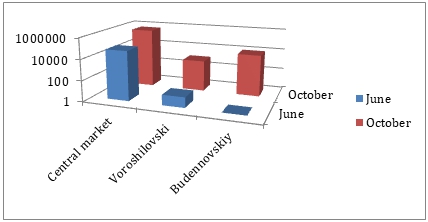
Fig. 4 - The MPN of coliform bacteria in soil samples, collected in Rostov-on-Don
The most probable number of coliform bacteria appeared to be very different in different parts of the city. The coliform index is the most common indicator of the fecal pollution and can be used as a quantificator of potential level of danger from soil, as extensive fecal pollution can lead to epidemics of salmonellosis, shigellosis and other intestine infections. It can be stated, that the coliform index was high and stable in the soil of central market and it was significantly higher than in two other sampling spots. This, together with other microbiological assessments, indicates constant contamination of soil in this place, as coliform bacteria do not survive long in soil conditions, being adapted to living in mammals intestine.
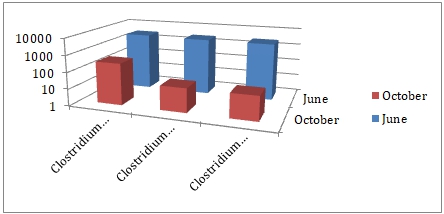
Fig. 5 - The MPN of Clostridium perfringens in soil samples, collected in Rostov-on-Don
The number of Clostridium perfringens in soil didn’t show strong difference between the samples in June, and there was no significant correlation with other groups of bacteria. Still, in October their number was 10 times higher in the soil of central market, which is considered to be the most polluted. This group is the only one that appeared to be more abundant in summer than in autumn in all three sampling spots. This is probably due to their ability of spore formation, which helps these bacteria to survive the lack of water in dry soil in summer.
qualitative analysis:
The qualitative analysis of soil has proved the presence of following species: Enterococcus faecium, Enterococcus avium, Escherichia coli, Achromobacter piechaudii, Aeromonas hydrophila, Achromobacter denitrificans, Enterobacter cloacae, many of which indicate fecal pollution or can cause opportunistic infections. It has been shown, that only comprehensive approach should be used in bacterial identification, as colony morphology or biochemical profile used separately can lead to major errors.
Our study has shown, that the properties of strains can be largely adjusted in soil, and a complex approach should be used to avoid errors in bacterial identification.
As a general conclusion, it should be mentioned that there is a variety of bacteria, capable of departing a soil environment to cause serious focal or systemic infection. Specific evolved virulence factors or the ability to grow in diverse, sometimes harsh, microenvironments may promote human infection. Questions regarding travel and soil exposure, by direct contact or ingestion, inoculation, or dust or aerosol inhalation, and some soil borne diseases have been shown to have higher incidence in people of some occupations, such as farmers, as well as to be affected by climatic, environmental and anthropogenic factors. Steps should be taken to identify which factors have the largest effect on disease incidence for each disease and so allow for measures to be taken or policy to be written to minimize the destructive effects and socioeconomic costs of soil borne diseases.
CONCLUSIONS:- The results have shown large difference between different areas of the city (up to 80 times.
- The estimation of threat level of soils has shown that all the studied soils were contaminated. Enterococcus index is considered very high in soil and can be considered dangerous in most Coliform index and Clostridium perfringens index have indicated variable level of threat in different seasons and places. The highest level of threat was stated for the soil of central market.
- The qualitative analysis of soil has proved the presence of following species: Enterococcus faecium, Enterococcus avium, Escherichia coli, Achromobacter piechaudii, Aeromonas hydrophila, Achromobacter denitrificans, Enterobacter cloacae, many of which indicate fecal pollution or can cause opportunistic infections.
- Evidence suggests that human activities which increase soil degradation processes can enhance soil borne disease incidence and so measures should be taken or policy written to minimize the destructive effects and socioeconomic costs of soil borne diseases.
Acknowledgement: I want to thank the Ministry of Higher Education and Scientific Research in Iraq for all the encouragement and support during scholarship program in Russia.
References
- Scandura J.E., Sobsey M.D. Viral and bacterial contamination on ground water from on site sewage treatment systems //Water Sci. Technol.. - 1997. - V. 35. – P .141–146
- Leclerc H., Schwartzbrod, Dei-Cas E.: Microbial Agents Associated with Water-borne Diseases.// B. infect. Dis.. - 2003. - P.1643-1654.
- United Kingdom Environmental Management:Water-Direct Report. 2010. Available from: http://www.water-direct.co. [Accessed 5-11-2010].
- Hamner S., Broadaway S.C., Mishra V.B., and Tripathi A.: Trace Metal Levels in Drinking Water. Health. J.. - 2010; 125-127
- Scandura J.E., Sobsey M.D. Viral and bacterial contamination on ground water from on site sewage treatment systems //Water Sci. Technol.. - 1997. - V. 35. – P .141–146
- Rosen B. H. et al. Waterborne pathogens in agricultural watersheds. – US Department of Agriculture, Natural Resources Conservation Service, Watershed Science Institute, 2000. – 62 p.
- National water and climate center -2013 http://www.wcc.nrcs.usda.gov/watershed/projects

